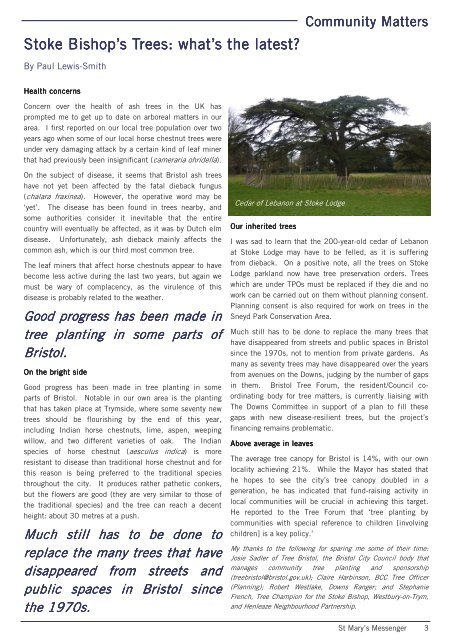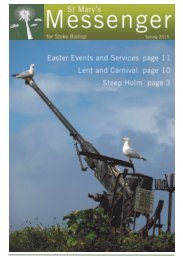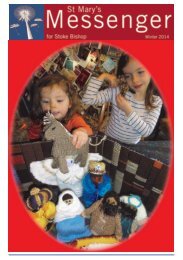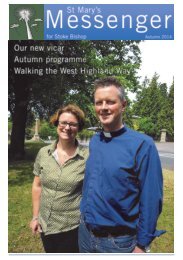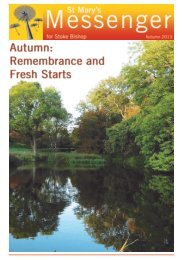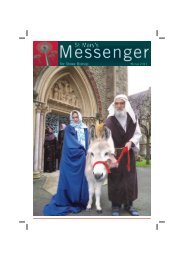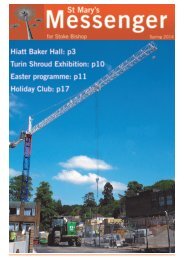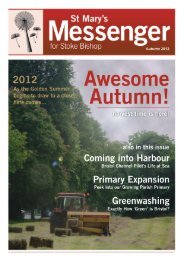You also want an ePaper? Increase the reach of your titles
YUMPU automatically turns print PDFs into web optimized ePapers that Google loves.
<strong>St</strong>oke <strong>St</strong>oke Bishop’s Bishop’s Trees: Trees: what’s what’s what’s the the latest?<br />
latest?<br />
By Paul Lewis-Smith<br />
Health Health concerns<br />
concerns<br />
Concern over the health of ash trees in the UK has<br />
prompted me to get up to date on arboreal matters in our<br />
area. I first reported on our local tree population over two<br />
years ago when some of our local horse chestnut trees were<br />
under very damaging attack by a certain kind of leaf miner<br />
that had previously been insignificant (cameraria ohridella).<br />
On the subject of disease, it seems that Bristol ash trees<br />
have not yet been affected by the fatal dieback fungus<br />
(chalara fraxinea). However, the operative word may be<br />
‘yet’. The disease has been found in trees nearby, and<br />
some authorities consider it inevitable that the entire<br />
country will eventually be affected, as it was by Dutch elm<br />
disease. Unfortunately, ash dieback mainly affects the<br />
common ash, which is our third most common tree.<br />
The leaf miners that affect horse chestnuts appear to have<br />
become less active during the last two years, but again we<br />
must be wary of complacency, as the virulence of this<br />
disease is probably related to the weather.<br />
Good Good Good Good progress progress progress progress has has has has been been been been made made made made in in in in<br />
tree tree tree tree planting planting planting planting in in in in some some some some parts parts parts parts of of of of<br />
Bristol. Bristol. Bristol. Bristol.<br />
On On the the the bright bright side side<br />
side<br />
Good progress has been made in tree planting in some<br />
parts of Bristol. Notable in our own area is the planting<br />
that has taken place at Trymside, where some seventy new<br />
trees should be flourishing by the end of this year,<br />
including Indian horse chestnuts, lime, aspen, weeping<br />
willow, and two different varieties of oak. The Indian<br />
species of horse chestnut (aesculus indica) is more<br />
resistant to disease than traditional horse chestnut and for<br />
this reason is being preferred to the traditional species<br />
throughout the city. It produces rather pathetic conkers,<br />
but the flowers are good (they are very similar to those of<br />
the traditional species) and the tree can reach a decent<br />
height: about 30 metres at a push.<br />
Much Much Much Much still still still still has has has has to to to to be be be be done done done done to to to to<br />
replace replace replace replace the the the the many many many many trees trees trees trees that that that that have have have have<br />
disappeared disappeared disappeared disappeared from from from from streets streets streets streets and and and and<br />
public public public public spaces spaces spaces spaces in in in in Bristol Bristol Bristol Bristol since since since since<br />
the the the the 1970s. 1970s. 1970s. 1970s.<br />
Cedar of Lebanon at <strong>St</strong>oke Lodge<br />
Our Our inherited inherited trees trees<br />
trees<br />
Community Community Matters<br />
Matters<br />
I was sad to learn that the 200-year-old cedar of Lebanon<br />
at <strong>St</strong>oke Lodge may have to be felled, as it is suffering<br />
from dieback. On a positive note, all the trees on <strong>St</strong>oke<br />
Lodge parkland now have tree preservation orders. Trees<br />
which are under TPOs must be replaced if they die and no<br />
work can be carried out on them without planning consent.<br />
Planning consent is also required for work on trees in the<br />
Sneyd Park Conservation Area.<br />
Much still has to be done to replace the many trees that<br />
have disappeared from streets and public spaces in Bristol<br />
since the 1970s, not to mention from private gardens. As<br />
many as seventy trees may have disappeared over the years<br />
from avenues on the Downs, judging by the number of gaps<br />
in them. Bristol Tree Forum, the resident/Council coordinating<br />
body for tree matters, is currently liaising with<br />
The Downs Committee in support of a plan to fill these<br />
gaps with new disease-resilient trees, but the project’s<br />
financing remains problematic.<br />
Above Above average average in in in leaves<br />
leaves<br />
The average tree canopy for Bristol is 14%, with our own<br />
locality achieving 21%. While the Mayor has stated that<br />
he hopes to see the city’s tree canopy doubled in a<br />
generation, he has indicated that fund-raising activity in<br />
local communities will be crucial in achieving this target.<br />
He reported to the Tree Forum that ‘tree planting by<br />
communities with special reference to children [involving<br />
children] is a key policy.’<br />
My thanks to the following for sparing me some of their time:<br />
Josie Sadler of Tree Bristol, the Bristol City Council body that<br />
manages community tree planting and sponsorship<br />
(treebristol@bristol.gov.uk); Claire Harbinson, BCC Tree Officer<br />
(Planning); Robert Westlake, Downs Ranger; and <strong>St</strong>ephanie<br />
French, Tree Champion for the <strong>St</strong>oke Bishop, Westbury-on-Trym,<br />
and Henleaze Neighbourhood Partnership.<br />
<strong>St</strong> Mary’s <strong>Messenger</strong> 3


